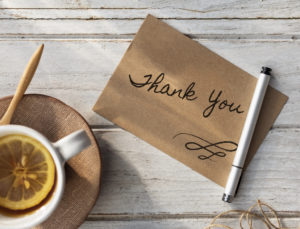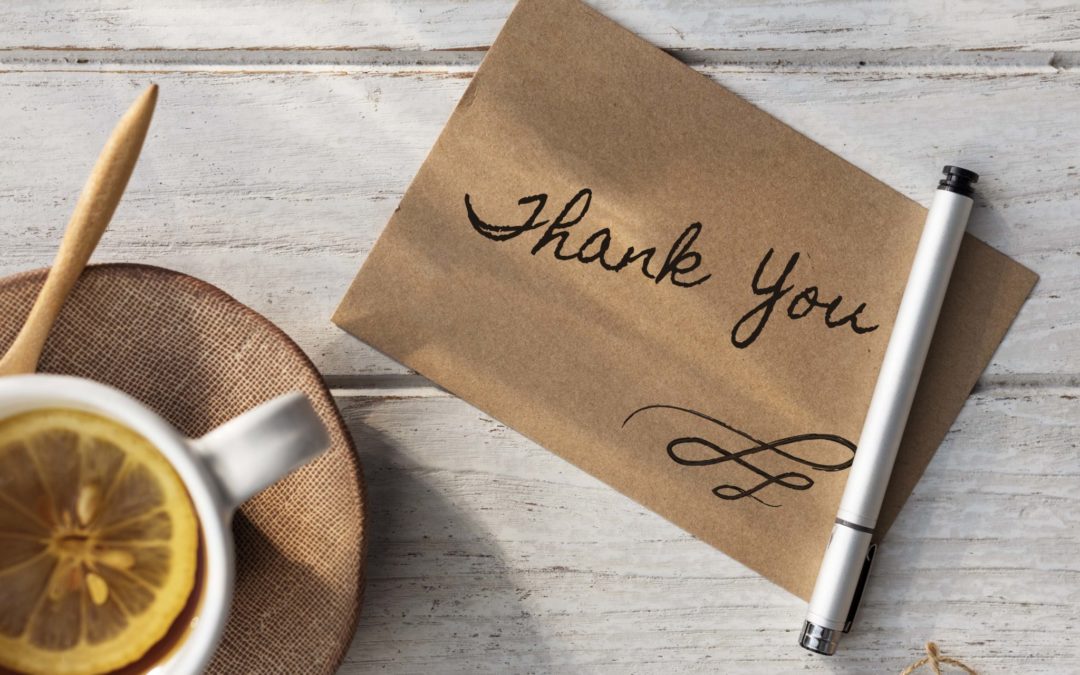When was the last time you received a thank you card or letter?
If you’ve ever watched a period-piece movie, perhaps based on a Jane Austen or Charlotte Brontë novel, one thing you’ll notice in these kinds of settings is the attention given to letters. Before typewriters, or email, letters were written by hand. The mail system was a lengthy process, often taking several weeks or months to deliver that letter. The recipient savored such letters and, at least in the movies, would stroll to the garden for quiet time and read and reread each word that was painstakingly composed using a quill pen (the original ballpoint!).
Thanks to the advancement of technology, there are multiple ways to send a thank you today.
However, the disadvantage is that the majority of people no longer put the same energy into creating that special thank you. For those who are not as articulate with words, there are plenty of cards designed to express how one feels, which then only requires a signature.
Email and text messaging has brought the art of saying thank you to a low position. As well, many are no longer raised with the understanding of the importance of thanking people for their self-sacrificing efforts.
Thank you cards are viewed as a social mannerly gesture, yet they are equally important in business.
Why a written thank you is hard
We have grown accustomed to viewing and hearing information at a rapid pace. Daily, we are inundated with the equivalent of 34GB of information through various sources.
As a result, we are distracted and our patience and tolerance has weakened.
On top of the challenges mentioned above, writing, phonics and the English language have played a minor role in schools, the result of which surrounds us. With the advent of technology, auto correct and text speak, youths struggle with stringing logical thoughts together on paper. The lack of coherence, unfortunately, continues into adulthood and affects their ability to effectively communicate, even through email.
Time management has become an enemy, and with the multiple responsibilities and tasks we are up against every day, taking a few minutes to pen a few sentences is often difficult.
Why a thank you is important
Think of an occasion you searched for the “perfect” gift for someone. It took time to research; time to drive to the place to pick it out, or order it online. Maybe you wrapped it and then hand-delivered your gift. Or you prepared it to mail to the recipient.
Or on another occasion you had guests to your home to share dinner. You spent time putting the menu together, purchasing ingredients, cooking the meal, prepping your home and then sharing your hard work with those friends.
Or you set aside time in your hectic schedule to meet with a colleague or contractor. You went out of your way to listen to this person. Perhaps you offered professional advice and even went beyond that by assisting him or her with something.
If you’ve been in any of the above situations, wouldn’t you like to know your efforts were welcomed? You shouldn’t have the attitude of doing something for people for the purpose of a thank you, but when they do thank you, how does that make you feel?
When others have done something nice or gone out of their way for us, the least we can do is take a few minutes to send a sincere thank you.
Which takes us to the opening question. When was the last time you received a thank you in the form of a letter or card? How did that make you feel? Can you make someone else feel the same?
Sending a thank you is simply good manners. In business, it is not only good manners, but the professional thing to do. We aim to have quality relationships in our business, and this is a simple gesture that reaches beyond expectations. When we know someone appreciates us and our efforts, we are more likely to repeat those efforts with that person.
Remember: an unthankful attitude breeds contempt.
How to do it
The method to writing a thank you is simpler than perceived. You don’t need to be articulate; you just need to be sincere.
Here are 4 steps to writing your “perfect” thank you:
1. The thank you
Begin with the thank you. Thank the person immediately for whatever it is he/she gave you. For example: “Thank you for taking the time with me the other day.” “Thank you for inviting me to dinner.” “Thank you for the gift basket.”
2. The gift/gesture
Tell the person why the gift or gesture was important to you. Express how you are using it, if applicable. For example: “I enjoyed our conversation and I look forward to future collaborations.” “The roast you prepared was excellent and I appreciate the hard work you put into the meal.” “My family (or office) enjoyed all the tidbits in the basket, especially the chocolate. The chocolate went first.”
3. Add something meaningful
Add something meaningful, if applicable. If your gift or gesture was from a friend, mention something personal between the two of you. “I appreciate your friendship.” If it was from a colleague or other business professional, you could say: “It was nice to meet with someone who is equally creative.” Or: “Your advice meant a lot to me as I try to reach my professional goals.” If none of this is applicable, move on to step 4.
4. The final thank you
Finish with a second thank you. Simply: “Again, thank you for your kind gesture.” “Thank you, again, for meeting with me.”
The opening salutation and closing will depend on the recipient. If it’s a friend, then it’s “Dear (friend’s name).” And the closing is “Sincerely Yours,” “Love,” “Truly Yours,” or whatever is appropriate for your relationship. If it’s a business professional, the opening is dependent on the extent of the relationship. Some can open with “Dear Max,” but most will be: “Dear Mr. Smith.” If it’s a woman, always use Ms. to avoid an awkward situation that Mrs. or Miss sometimes creates. The closing will always be “Sincerely.”
When to send
Send a thank you card or letter when:
- You have been given a gift (i.e., wedding)
- Someone made a nice gesture (i.e., took you out to lunch)
- You met with a business professional
- You had a job interview
- You were invited to an event or to someone’s home (i.e., a business event, social party)
- You are proud of an employee
Send your thank you immediately. Preferably the same day or within the week at most. The reason this is important is because the situation is still fresh in your mind and your reaction is clear. As the days roll by, you might forget your excitement over the gesture or key points discussed at the meeting. However, if it takes you longer to send that thank you note than anticipated, avoid apologizing in the note, i.e., “I’m sorry this is late,” “I forgot you,” etc.
Compose a quick draft on scratch paper and then when you have your thoughts fleshed out, write it neatly on the card. You can also send a letter, either handwritten or typed. The envelope should be handwritten if your writing is neat. Check your spelling, grammar and punctuation. Read your draft out loud to help you catch mistakes.
Do not send a card with multiple mistakes. Granted, sometimes we do make a mistake and have to cross something out, so do this with one line as neatly as possible. But if you make multiple errors, replace the card or paper.
The written thank you is indeed an art. While we are not all artists, we can show gratitude for kindness. This gesture is an easy way to endear ourselves to others and strengthen business relationships. Do not allow this expression to disappear because of a hectic schedule.
Our mundane responsibilities will not go away, but we could lose out on a valuable relationship if we cannot make the time to say “thank you.”

Want a quick guide?
Download the cheat sheet: “Write a thank you”


Recent Comments